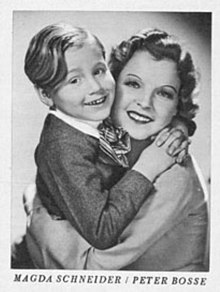The woman at the crossroads
| Movie | |
|---|---|
| German title | The woman at the crossroads |
| Original title | in Hungary Asszony a válaszúton |
| Country of production |
Germany Hungary |
| original language | German |
| Publishing year | 1938 |
| length | 95 minutes |
| Age rating | FSK 16 f |
| Rod | |
| Director | Josef von Báky |
| script | Thea of Harbou |
| production | Willy Reiber for Pictura-Film |
| music | Viktor Vaszy |
| camera | Stefan Eiben |
| cut | Wolfgang Becker |
| occupation | |
| |
Die Frau am Scheidewege (Subtitle: The Fate of a Doctor ) is a German-Hungarian melodrama from 1938 directed by Josef von Báky . The main roles are occupied by Magda Schneider , Ewald Balser , Karin Hardt and Hans Söhnker .
The film is based on Alice Lyttken's novel Kommer inte till middagen ( I'm not coming to dinner ).
action
Miss Dr. med. Hanna Weigand breaks down after working exhaustively for days on end. Her boss, Professor Henrici, then sends her on vacation for four weeks. The young doctor resists it. But when the professor assures her that he urgently needs her to be completely healthy and recovered, because without her he could no longer work properly, she gives in. On the train, Hanna meets the charming painter Fred Möbius. The two quickly become a couple, and they soon get married. It turns out, however, that the serious young woman, who loves her job more than anything, and Fred, who takes life easy in his artistic-lively way, do not go together. The painter feels increasingly drawn to Hanna's sister Ellinor, a young fashion illustrator. Hanna, on the other hand, resumes her professional activity with Henrici, who was always a role model for her and whom she had missed not only because of his unpretentious nature.
The young couple has to admit that they have arrived at a crossroads and that the hasty marriage that resulted from their first love was premature. Hanna also admits that she not only needs her job, but also the man who trained her to be an exemplary doctor and with whom she has so much in common. In addition to the admiration and great appreciation she shows him, he also owns her love. Together with him she will master life, side by side in the operating room as well as in private life. And in Ellinor Peter found the woman who really suits him.
Production notes and background
The film was shot from March 20 to early May 1938 in Budapest , Hungary, among other places . It is a Pictura film made in the Hunnia Film Ateliers in Budapest. Willy Reiber was in charge of production . Emil Hasler was responsible for the film construction .
The ten-act film with a length of 2590 meters premiered on August 26, 1938 in Karlsruhe. On October 12, 1938, it started in the Berlin Capitol am Zoo . In the GDR it first came to the cinema on March 9, 1962. The film premiered on television on November 20, 1961 at DFF 1 . The work was also shown in theaters in Sweden, Finland, Denmark, France and Hungary. Asszony a válaszúton was filmed at the same time for the Hungarian cinema-goers .
Karlheinz Wendtland used the film to say that it was “again proof” that the blanket claim that in the 'Nazi film' women had to forego work and careers is untenable ”.
criticism
For the lexicon of international film , the film was merely a "pseudo-tragic social melodrama in the medical environment".
The Mainfränkische Zeitung dealt with the person Magda Schneider on the occasion of the sixth week of the film in the Würzburg cinema Emelka and wrote at the time: “Well, if you know her from the film as Frau Hanna - the woman at the crossroads - you will also find her in Reality like that. Simple, pretty, amiable and unaffected, with a cheerful disposition and with a winning, open look that allows you to make wonderful contact immediately. "
Karlheinz Wendtland wrote about the film: “The conflicts are portrayed credibly. With a lot of human understanding, the plot moves forward dramatically. Careful direction ensures that everything runs safely with a sure instinct. With her kind heart and determination, Magda Schneider recalls her excellent work such as Liebelei […] and The Path of the Heart . ”Wendtland focused on the treatises on German film (year 1938/39, p. 137), where you can find a successful one The type of doctor I presented was different from Magda Schneider, and she was of the opinion that it was forgotten that she was “able to depict sensitive and serious characters”. Wendtland went on to write: "This role was only blurred because she mostly had to play the sweet and charming girl, which the movie masters had determined her to be." show the best performance. A pleasant film. "
See also
Web links
- The woman at the crossroads in the Internet Movie Database (English)
- The woman at the crossroads at filmportal.de
- The woman at the crossroads - The fate of a doctor IFK No. 2810 and Progress Filmillustr. No. 24/62 at virtual-history.com
- Woman at the Crossroads re-performance poster
Individual evidence
- ↑ a b Karlheinz Wendtland: Beloved Kintopp . All German feature films from 1929–1945 with numerous artist biographies. Born in 1937 and 1938. Medium Film Verlag Karlheinz Wendtland, Berlin, Second revised edition, pp. 180, 181
- ↑ The woman at the crossroads. In: Lexicon of International Films . Film service , accessed March 2, 2017 .
- ↑ Margit Maier: The business with dreams: Cinema culture in Würzburg , p. 76
